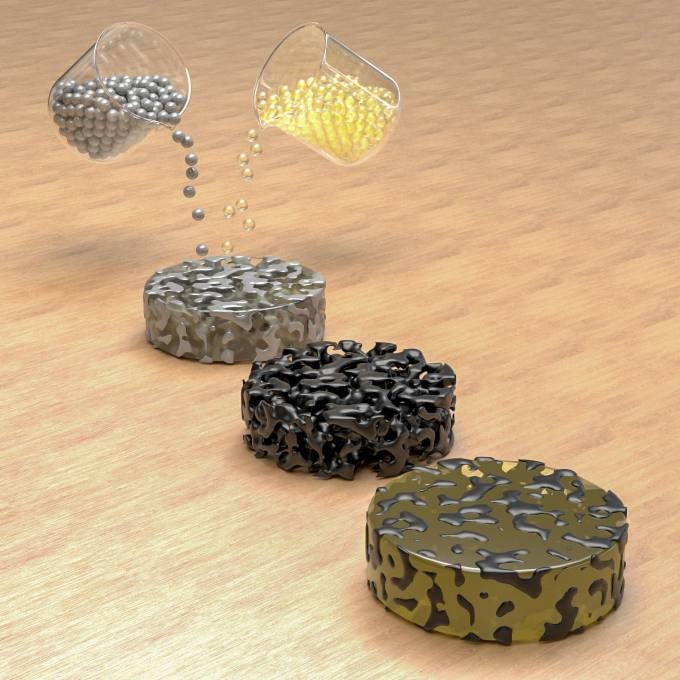Nov 15 2018
Scientists at Rice University have built an improved epoxy for electronic applications.
 Researchers have created an epoxy-graphene foam compound that is tough and conductive without adding significant weight. (Courtesy of the Rouzbeh Shahsavari Group)
Researchers have created an epoxy-graphene foam compound that is tough and conductive without adding significant weight. (Courtesy of the Rouzbeh Shahsavari Group)
Epoxy blended with “ultrastiff” graphene foam invented in the Rice lab of chemist James Tour is significantly tougher than pure epoxy and a lot more conductive than other epoxy composites while preserving the material’s low density. It could enhance upon epoxies in current use that deteriorate the material’s structure with the incorporation of conductive fillers.
The new material is described in the American Chemical Society journal ACS Nano.
Independently, epoxy is an insulator and is widely used in adhesives, coatings, industrial tooling, electronics, and structural composites. Carbon or metal fillers are frequently added for applications where conductivity is preferred, like electromagnetic shielding.
But there is a trade-off: More filler offer higher conductivity at the cost of weight and compressive strength, and the composite turns out to be harder to process.
The Rice solution swaps carbon or metal powders with a three-dimensional foam composed of nanoscale sheets of graphene, the atom-thick form of carbon.
The Tour lab, in partnership with Rice materials scientists Pulickel Ajayan, Rouzbeh Shahsavari and Jun Lou and Yan Zhao of Beihang University in Beijing, drew their motivation from projects to inject epoxy into 3D scaffolds including graphene aerogels, skeletons, and foams from numerous processes.
The new scheme makes much sturdier scaffolds from polyacrylonitrile (PAN), a powdered polymer resin they use as a source of carbon, blended with nickel powder. In the four-step procedure, they cold-press the materials to render them dense, heat them in a furnace to convert the PAN into graphene, chemically treat the resultant material to eliminate the nickel and utilize a vacuum to pull the epoxy into the currently-porous material.
The graphene foam is a single piece of few-layer graphene. Therefore, in reality, the entire foam is one large molecule. When the epoxy infiltrates the foam and then hardens, any bending in the epoxy in one place will stress the monolith at many other locations due to the embedded graphene scaffolding. This ultimately stiffens the entire structure.
James Tour, T.T. and W.F. Chao Chair in Chemistry, Professor of Computer Science and of Materials Science and Nanoengineering, Rice University.
The puck-shaped composites with 32% foam were slightly denser, but possessed an electrical conductivity of about 14 Siemens (a measure of conductivity, or inverse ohms) per centimeter, according to the scientists. The foam did not add major weight to the compound but bestowed it seven times the compressive strength of pure epoxy.
Easy interlocking between the graphene and epoxy aided in stabilizing the structure of the graphene as well. “When the epoxy infiltrates the graphene foam and then hardens, the epoxy is captured in micron-sized domains of the graphene foam,” Tour said.
The lab took a risk by blending multi-walled carbon nanotubes into the graphene foam. The nanotubes served as reinforcement bars that bonded with the graphene and rendered the composite 1,732% stiffer than pure epoxy and almost three times as conductive, at around 41 Siemens per centimeter, far greater than virtually all of the scaffold-based epoxy composites reported thus far, according to the scientists.
Tour supposes the process will scale for industry. “One just needs a furnace large enough to produce the ultimate part,” he said. “But that is done all the time to make large metal parts by cold-pressing and then heating them.”
He said the material could primarily substitute the carbon-composite resins used to pre-impregnate and strengthen fabric used in materials from tennis rackets to aerospace structures.
Visiting Rice student Xiao Han, a graduate student at Beihang University, and Rice graduate student Tuo Wang are the paper’s co-lead authors. Co-authors are Rice alumni Peter Samora Owuor and Jongwon Yoon, graduate student Sung Hoon Hwang, visiting scholars Chao Wang and Lulu Shen, and postdoctoral researchers Weipeng Wang and Rodrigo Villegas Salvatierra; and Junwei Sha of Tianjin University, China.
Ajayan is chair of Rice’s Department of Materials Science and NanoEngineering, the Benjamin M. and Mary Greenwood Anderson Professor in Engineering and a professor of chemistry. Shahsavari is an assistant professor of civil and environmental engineering and of materials science and nanoengineering. Lou is a professor of materials science and nanoengineering. Zhao is a professor at Beihang University. Tour is the T.T. and W.F. Chao Chair in Chemistry as well as a professor of computer science and of materials science and nanoengineering at Rice.
The research was supported by the Air Force Office of Scientific Research and the China Scholarship Council.